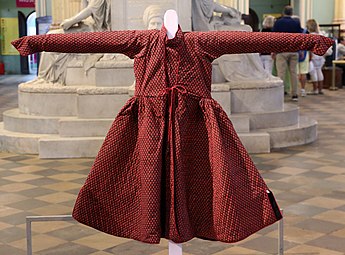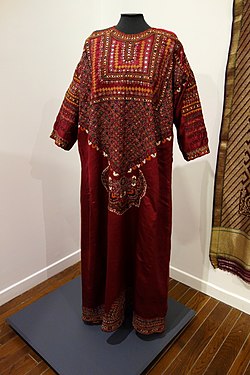Angarkha
Angarkha or Angi, refers to the most common upper body garment with a usual asymmetrical opening in the chest area reaching down to
the knees, knotted or secured traditionally by strings worn by men in the Indian subcontinent, especially before the introduction of the 'Kurta'. Its various forms exist mostly throughout Northern South Asia. Angarkha was predominant in various parts of the Indian subcontinent, but while the basic cut remained the same, the style and length varied from region to region.[1] Angarakhas are of the waist-length and knee-length reaching below the knees, both of which can be flared so to appear as either a waist or knee-length frock.
In the 21st century, modern and simpler designs are usually a casual or semi-casual upper garment for both the genders. The Achkan and Sherwani are the descendants of Angarkha.
Etymology[edit | edit source]
Angarkha comes from the Sanskrit Script error: The function "transl" does not exist., meaning 'body-protector'.[2]
Traditional types[edit | edit source]
- Jama (Gujarat), which has an asymmetric opening with the skirt flaring out to around the hips. However, some styles fall to below the knees.[3][4]
- Kediyu (Gujarat), it is a long sleeved upper garment, pleated at the chest and reaching to the waist. Some designs, however, flare out to the knees. The prints on the kediyu include bandhani designs which are local to Gujarat and Rajasthan.[5][6] Some designs, however, flare out to the knees. The prints on the kediyu include bandhani designs which are local to Gujarat and Rajasthan.[7]
- Bandia (Rajasthan), worn above the waist and fastened with tapes either over the chest or on the shoulder, with long arms and narrow sleeves. The prints on the Rajasthani garments include sanganer prints which are of local origin.[8][9][10][11]
- Mirjai (Bihar), is a modified form of the flowing robe (known as the jama) fastened on the right. The Mirjai is an under jacket with long loose sleeves and open cuffs.[12] fastened on the right.[13][14]
- Kamari (Gujarat and Rajathan)
- Anga or Peshwaj, the female version of which flowed to the ankles and male version to the knees; it is fastened with a flap to the side and is worn with a front opening kurta. A commonality in Punjab, Haryana and Himachal.[15] it is a loose tunic[16] that falls to below the knees,[17] is fastened with a flap to the side and is worn with a front opening kurta.[18][19][20] and peshwaj)[21]
- Chamba (Himachal), is sewn tight at the torso, but below the waist it has an open fall like the modern skirt. It is tied at the waist with a sash.[22]
- Kalidar (Uttarakhand)[23]
- Angerkho (Sindh)
Related garments[edit | edit source]
Jhabbho[edit | edit source]
Another upper garment worn in Gujarat is the jhabbho which is a long robe.[24] The jhabho is also called the abho which is also worn by women of Rajasthan. The garment is loose, with short, wide sleeves, open at the neck, loose-fitting on the upper part and very flared at the skirt. The abho is often decorated in embroidery and mirror work.[25]
Saluka[edit | edit source]
A short sleeve cotton shirt, without a collar,[26] to the waist (called saluka[27] or ganji)[28] is traditionally worn in Uttar Pradesh.[29] The saluka is also traditionally worn in Madhya Pradesh.[30]
Cholo[edit | edit source]
The female Sindhi cholo[31][32] is loose fitting,[33] and is made in a variety of ways, including the traditional method of the cholo opening at the front to the waist,[34][35] with very wide sleeves.[36] The traditional cholo can reach down to the ankles.[37]
Images[edit | edit source]
Samudragupta depicted with angarkha, Gupta Empire.
See also[edit | edit source]
References[edit | edit source]
- ↑ Kumar, Ritu (2006) Costumes and textiles of royal India
- ↑ Zaira Mis, Marcel Mis (2001) Asian Costumes and Textiles: From the Bosphorus to Fujiama [1]
- ↑ Tierney, Tom (2013) Fashions from India
- ↑ Sarosh Medhora (02.09.2000) The Tribune. Focus on men’s formals
- ↑ Swaminarayan (2006) Vachanamrut
- ↑ Simran Ahuja (2014) Nine Nights: Navratri
- ↑ Murphy, Veronica and Crill, Rosemary (1991) Tie-dyed Textiles of India: Tradition and Trad [2]
- ↑ Koṭhārī, Gulāba (1995) Colourful textiles of Rajasthan
- ↑ Bhandari, Vandana (2005) Costume, textiles and jewellery of India: traditions in Rajasthan [3]
- ↑ Ghurye, Govind Sadashiv (1966) Indian Costume
- ↑ Rajasthan [district Gazetteers].: Baran (1997) [4]
- ↑ Winer, Lise (2009) Dictionary of the English/Creole of Trinidad & Tobago: On Historical Principles [5]
- ↑ O`malley, L.S.S. (1924) Bihar And Orissa Gazetteers Shahabad
- ↑ The Eastern Anthropologist, Volumes 27-28 (1974)
- ↑ Kumar Suresh Singh, V. Bhalla, Swaran Singh (1997) Chandigarh
- ↑ Punjab District Gazetteers: Ibbetson series, 1883-1884]. [6]
- ↑ Punjab gazetteers, 1883, bound in 10 vols., without title-leaves (1883) [7]
- ↑ Punjab District Gazetteers Karnal 1919
- ↑ Rajaram Narayan Saletore (1974) Sex Life Under Indian Rulers
- ↑ Panjab University Research Bulletin: Arts, Volume 13, Issue 1 - Volume 14, Issue 1 (1982) [8]
- ↑ B. N. Goswamy, Kalyan Krishna, Tarla P. Dundh (1993) Indian Costumes in the Collection of the Calico Museum of Textiles, Volume 5 [9]
- ↑ Kamal Prashad Sharma, Surinder Mohan Sethi (1997) Costumes and Ornaments of Chamba [10]
- ↑ Uttar Pradesh District Gazetteers: Uttarkashi 1979
- ↑ Nair, Usha (1979) Gujarati Phonetic Reader
- ↑ Maitra, K.K (2007) Encyclopaedic Dictionary of Clothing and Textiles
- ↑ Sameera Maiti (2004) The Tharu: Their Arts and Crafts
- ↑ Uttar Pradesh District Gazetteers: Deoria (1998)
- ↑ Singh, K. S. Anthropological Survey of India (2005) Uttar Pradesh, Volume 1 [11]
- ↑ Census of India, 1961: Uttar Pradesh
- ↑ Madhya Pradesh: district gazetteers, Volume 31 (1994)
- ↑ I am a Sindhi: The Glorious Sindhi Heritage and Culture and Folklore of Sindh J P Vaswami
- ↑ Sindh and The Races That Inhabit the Valley of the Indus Richard F Burton
- ↑ Askari, Nasreen and Crill, Rosemary Colours of the Indus: Costume and Textiles of Pakistan (1997) [12]
- ↑ Perspective, Volume 3, Issue 2 (1970)
- ↑ Weekly of Pakistan, Volume 20, Issues 27-39 (1968)
- ↑ Papers by Command, Volume 68. Great Britain. Parliament. House of Commons H.M. Stationery Office, 1979 - Legislation [13]
- ↑ Chaukhandi tombs in Pakistan (1996)








